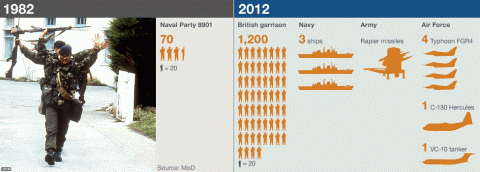The BBC has a then-and-now summary of the military balance in the south Atlantic in 1982 and today:
1982: On the eve of the invasion, there were about 70 Royal Marines stationed on the islands — twice the usual number due to a changeover. They were, in theory, backed up by about 120 local reservists, although only a small proportion reported for duty. HMS Endurance, an Antarctic ice patrol vessel, was the only ship based in the South Atlantic at the time. And there were no fighter jets — none of the island’s airstrips were long enough. The only planes that could land before the war came from Argentina. Supplying the Falklands by sea from Britain took two weeks.
2012: The major difference is the construction of RAF Mount Pleasant, a modern air base housing four Eurofighter Typhoon strike fighters, a Hercules transport plane and VC-10 tanker plane. There are also Rapier missile batteries in several locations. The British garrison numbers 1,200, including 100 infantrymen, with 200 reservists in the Falkland Islands Defence Force. The Royal Navy has a patrol vessel, an auxiliary support ship, and frigate or state-of-the-art destroyer. It’s reported that a British nuclear-powered submarine is in the South Atlantic, but the Ministry of Defence will not discuss operational matters. “It’s quite a considerable deterrent force,” says Peter Felstead, editor of Jane’s Defence Weekly. Military experts believe the islands are now virtually impregnable. Any sign of Argentine invasion and the islands could be quickly reinforced by air.
Just as we established the last time this was up for discussion, Argentina doesn’t have the military forces for a stand-up fight, but if they can take the RAF base in a surprise attack by special forces, Britain probably can’t recapture the islands.




